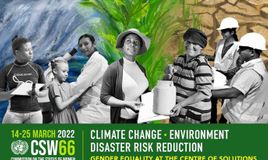Amplifying women & youth initiatives to combat climate change

In this blog we share some of the highlights of the official CSW side-event ‘Amplifying women & youth initiatives to combat climate change’.
Robbert Dijkgraaf (Minister of Education, Culture and Science), Enaam Ahmed Ali (UN Women’s representative 2022 for the Netherlands) Lilian Gregorio (WECF Gender-Just Climate Solutions Award winner), and Esin Erdogan (member of the National Youth Climate Movement) discussed feminist and youth-led solutions to successfully fight the climate and environmental crises.
Solutions, good practices and lessons to be learned
In the first session, we discussed some good practices, solutions and lessons to be learned. In the Netherlands, the Youth Climate Movement has a unique vision, ideas and perspective according to Esin Erdogan. She emphasized the important role and perspective of youth in discussing the climate crisis. Esin Erdogan emphasized that sustainability is often associated with feminine values such as caring for your environment, and making sustainable choices regarding clothes and food. It is the women that are taking responsibility. But how do we ensure that this burden of responsibility does not only lie with women and girls? How do we ensure that men and boys are able to make these same environmentally conscious decisions? On the one hand, we must counteract the stereotypes that underly the notion that ‘green choices’ are too feminine for men and boys. Simultaneously, we must embrace feminine values in society. Caring for our planet, our lived environment is behaviour that we must encourage and embrace.
Lilian Gregorio emphasizes the need of building a strong network of women’s human right defenders in Latin America. This is needed to make women’s voices visible, to further build and strengthen their positions, as well as undermine the power of patriarchy in communities and society at large. Another solution and best practice that was raised by Enaam Ahmed Ali is technology as a key driver for the current environmental crisis we are in right now. Technology is simultaneously the culprit of much environmental degradation, but should also be embraced as a solution to a more sustainable future.
What are the challenges and what contradictions do we see in the climate-gender nexus?
After we discussed good practices and solutions, we talked about some of the challenges. One of them is the difficulty in reaching people that less easily mobilize themselves. For example, reaching youth with a practical rather than a theoretical education. Another challenge is funding. Mobilizing and coordinating takes up a lot of time and energy. There is a lack of funding, which leads to many organizations being led by passionate volunteers who are not adequately compensated for their work.
When we look at the Netherlands, there is an overall lack of women in climate professions and in leadership positions. Girls and women are underrepresented in technology education and research at all levels. The same applies to the energy sector and to all climate professions. This underrepresentation matters as we have just discussed that ‘green choices’ – caring for the lived environment – are seen as inherently feminine.
On a global scale, when we are looking at technological upscaling and solutions, we cannot forget that a large part of the world experiences technological poverty. The people most vulnerable to the changing climate are therefore the most likely to be left behind in any technological solutions. What is needed is long-term funding, specifically reaching the local communities that are already working on solutions that are rooted in communities.
What is needed to create more impact and further amplify these solutions? How do we support each other?
Gender disaggregated data is crucial to assess the implications of climate and gender policies on all individuals. Our current policy is often gender neutral. Terms like ‘households and ‘consumer’ do not pay attention to the differences and inequalities in needs, opportunities and situations of women and girls. Besides that, accessible and flexible funding for feminist and community-based grassroot organizations and solutions is needed. Finally, combatting poverty is one of the most important factors to ensure that women have a better and more resilient position in life. This means that while there is a role for technology in combatting the gendered impact of the changing climate, the response should be multi-faceted and include education, health information and sustainable agriculture.
Closing statement minister Dijkgraaf
The Netherlands plays a leadership role internationally when it comes to speaking out on gender equality in climate policy and women leadership in local communities, according to minister Dijkgraaf. But we tend to forget that we still have a lot of work to do in our own country as well. As a scientist, the Minister acknowledged the importance of gender-disaggregated data and that we need to use existing knowledge of women and girls in local communities. The knowledge is already there, but we have to make sure that these voices get heard and amplified. Finally, the Minister emphasized the importance of full, meaningful and equal participation of women and girls in decision making processes. He also mentioned the responsibility of men and boys, and committed to lead by example, since “we don’t have to convince women, we have to convince men.”
Atria and WO=MEN are jointly responsible for the coordination of input from civil society to the governmental delegation during the 66th session of Commission on the Status of Women in New York. Follow us on Twitter: @AtriaNieuws and @genderplatform.
Image: UN Women / Amanda Voisard

